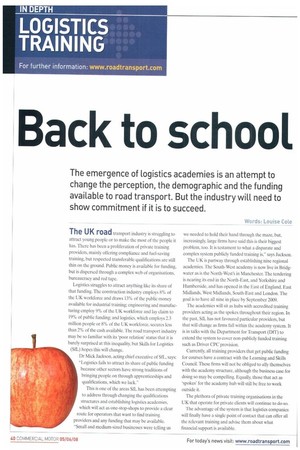ack to school
Page 40

Page 41

If you've noticed an error in this article please click here to report it so we can fix it.
The emergence of logistics academies is an attempt to change the perception, the demographic and the funding available to road transport. But the industry will need to show commitment if it is to succeed.
Words: Louise Cote The UK road transport industry is struggling to attract young people or to make the most of the people it has. There has been a proliferation of private training providers, mainly offering compliance and fuel-saving training, but respected transferable qualifications are still thin on the ground. Public money is available for funding, but is dispersed through a complex web of organisations, bureaucracy and red tape.
Logistics struggles to attract anything like its share of that funding. The construction industry employs 8% of the UK workforce and draws 13% of the public money available for industrial training; engineering and manufacturing employ 9% of the UK workforce and lay claim to 19% of public funding; and logistics, which employs 2.3 million people or 8% of the UK workforce. secures less than 2% of the cash available. The road transport industry may be so familiar with its 'poor relation' status that it is barely surprised at this inequality, but Skills for Logistics (SfL) hopes this will change.
Dr Mick Jackson. acting chief executive of SfL, says: "Logistics fails to attract its share of public funding because other sectors have strong traditions of bringing people on through apprenticeships and qualifications, which we lack."
This is one of the areas SIL, has been attempting to address through changing the qualifications structures and establishing logistics academies, which will act as one-stop-shops to provide a clear route for operators that want to find training providers and any funding that may be available. "Small and medium-sized businesses were telling us we needed to hold their hand through the maze, but, increasingly, large firms have said this is their biggest problem, too. It is testament to what a disparate and complex system publicly funded training is," says Jackson.
The UK is partway through establishing nine regional academies. The South-West academy is now live in Bridgwater as is the North-West's in Manchester. The tendering is nearing its end in the North-East, and Yorkshire and Humberside, and has opened in the East of England, East Midlands, West Midlands, South-East and London. The goal is to have all nine in place by September 2009.
The academies will sit as hubs with accredited training providers acting as the spokes throughout their region. in the past, SfL has not favoured particular providers, but that will change as firms fall within the academy system. It is in talks with the Department for Transport (DfT) to extend the system to cover non-publicly funded training such as Driver CPC provision.
Currently, all training providers that get public funding for courses have a contract with the Learning and Skills Council. These firms will not be obliged to ally themselves with the academy structure, although the business case for doing so may be compelling. Equally, those that act as 'spokes' for the academy hub will still be free to work outside it.
The plethora of private training organisations in the UK that operate for private clients will continue to do so.
The advantage of the system is that logistics companies will finally have a single point of contact that can offer all the relevant training and advise them about what financial support is available.
Qualifications
Publicly funded training includes basic literacy and numeracy; English as a second language; vocational qualifications such as HGV driving, administration, warehousing, logistics services, van driving etc. One of the problems to date with these courses is that the National Vocational Qualification (NVQ) focuses entirely on practical skills and has little respect from either employers or the academic arena.
The accreditation of NVQs has rested with the Qualifications and Curriculum Authority (QCA). However, Sit has now taken responsibility for all logistics qualifications and is rewriting them with a new mix of required skills.
Jackson says that all jobs require a mix of skills: 70% logistics craft, 10-15% behavioural or core skills (interpersonal, service), and 10-15% specific supply chain knowledge eg ADR, temperature control etc.
Traditionally, people would be taught core skills only when they reached management level and many managers would have too little training in craft skills. This is no longer sufficient, which is why Sit is rewriting the curricula in an attempt to give genuinely useful, transferable skills all the way up the career path. The first one is Driving Goods Vehicles, which should be ready by autumn 2008.
A national logistics academy
The freight industry has already put in one bid for funding for a national logistics academy, which would unite the regional outposts and hopefully bring higher status, more public funding and much-needed new recruits into the industry. However, while construction and retail now have their national centres, logistics didn't make it to the second round.
But Jackson is not prepared to give up and says the government is looking for serious commitment both financial and in terms of enthusiasm and support from across the sector. Logistics is competing against wellfunded and high profile rivals such as BHS and Dyson Engineering, which have thrown their support behind their sectors' bids. Jackson feels it is time the logistics industry whipped up support from the many high-profile names that depend upon its services for their survival.
"We need to marshal the sector, and ramp up support region by region," he says, "There is a reason only 9% of the 2.3 million people in logistics are under 25." Could this be a chance to change that? •








































































































































































